非谓语havingdone的用法
- 格式:docx
- 大小:14.96 KB
- 文档页数:1

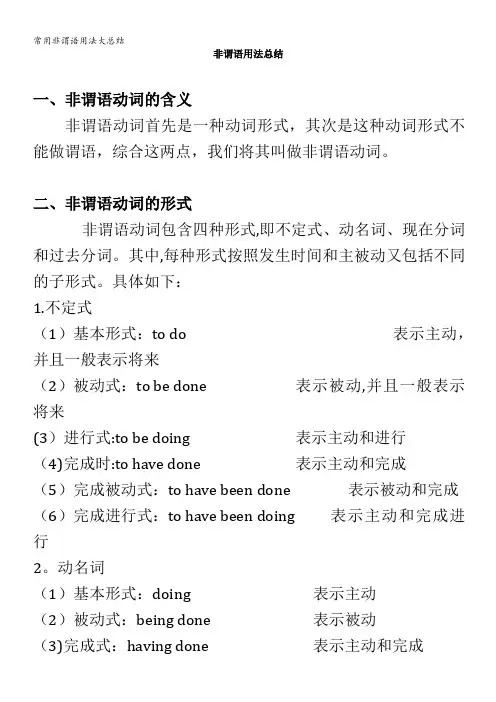
非谓语用法总结一、非谓语动词的含义非谓语动词首先是一种动词形式,其次是这种动词形式不能做谓语,综合这两点,我们将其叫做非谓语动词。
二、非谓语动词的形式非谓语动词包含四种形式,即不定式、动名词、现在分词和过去分词。
其中,每种形式按照发生时间和主被动又包括不同的子形式。
具体如下:1.不定式(1)基本形式:to do 表示主动,并且一般表示将来(2)被动式:to be done 表示被动,并且一般表示将来(3)进行式:to be doing 表示主动和进行(4)完成时:to have done 表示主动和完成(5)完成被动式:to have been done 表示被动和完成(6)完成进行式:to have been doing 表示主动和完成进行2。
动名词(1)基本形式:doing 表示主动(2)被动式:being done 表示被动(3)完成式:having done 表示主动和完成(4)完成被动式:having been done 表示被动和完成3.现在分词(1)基本形式:doing 表示主动和进行(2)被动式:being done 表示被动和进行(3)完成式:having done 表示主动和完成(4)完成被动式:having been done 表示被动和完成4.过去分词(1)done,及物动词的过去分词表示被动或完成;(2)不及物动词的过去分词表示主动或完成三、专题要点非谓语动词和独立主格结构主要用法如下:1。
动名词和动词不定式作主语、宾语;2。
只跟动名词作宾语的动词或动词短语;3.只跟动词不定式作宾语的常见动词;4.既可以跟动名词又可以跟动词不定式作宾语,且意义不同的动词或短语;5。
不定式、现在分词、过去分词作宾语补足语的区别;6。
不定式、现在分词、过去分词作定语时的区别;7。
不定式、现在分词、过去分词作状语时的区别;8。
动名词的复合结构在句中作状语;9.there be 结构的两种非谓语形式;10.独立主格结构在句中作状语;11。
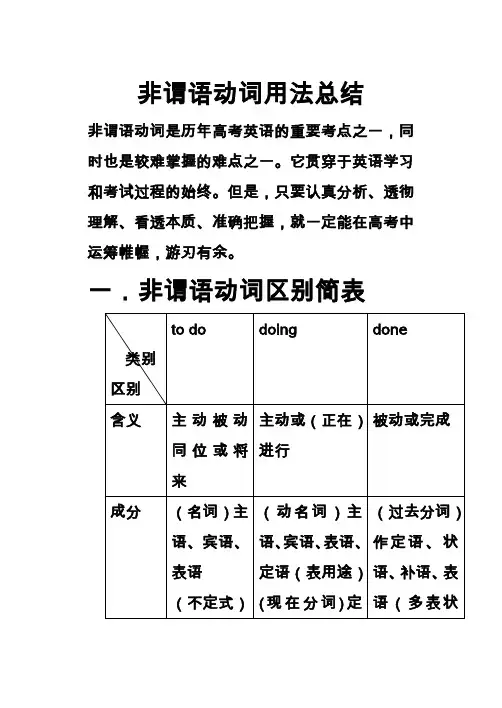
非谓语动词用法总结非谓语动词是历年高考英语的重要考点之一,同时也是较难掌握的难点之一。
它贯穿于英语学习和考试过程的始终。
但是,只要认真分析、透彻理解、看透本质、准确把握,就一定能在高考中运筹帷幄,游刃有余。
一.非谓语动词区别简表二.不定式的用法不定式不可作谓语,但它可以有自己的宾语、状语,构成不定式短语,在句中可以作主语、宾语、表语、定语(表用途)、状语或补足语。
高考对不定式的考查主要有不定式的时态、语态、作用、否定、省略、连词+不定式等。
作主语不定式作主语表示具体的动作,通常指一件已知的事或目的。
不定式作主语时,谓语动词用单数。
eg:To say is a thing,to do is another.(说是一回事,做是另外一回事。
)(2)不定式短语较长时,通常放在谓语之后,用it作形式主语。
eg:①It is important to learn English well.(学好英语是重要的。
)②It is necessary for us to do the job well.(我们做好这项工作是必要的。
)③It is a great honor to be invited to give a speech here.(被邀请在这儿发表演讲是一个极大的荣幸。
)2.作宾语(1)常只用不定式作宾语的动词有:want,wish,hope,long,expect,desire,intend,decid e,ask,promise,aim,offer,agree,plan,learn,choos e,refuse,fail,manage,pretend等。
eg:①He refused to help me.(他拒绝帮助我.)②She has agreed to come tomorrow.(他已同意明天来.)(2) 不定式较长时,作宾语,也可用it代替,放在后面。
eg;I find it difficult to do the job well.(3) “特殊疑问词﹢不定式to do结构”具有名词特征,可作宾语。

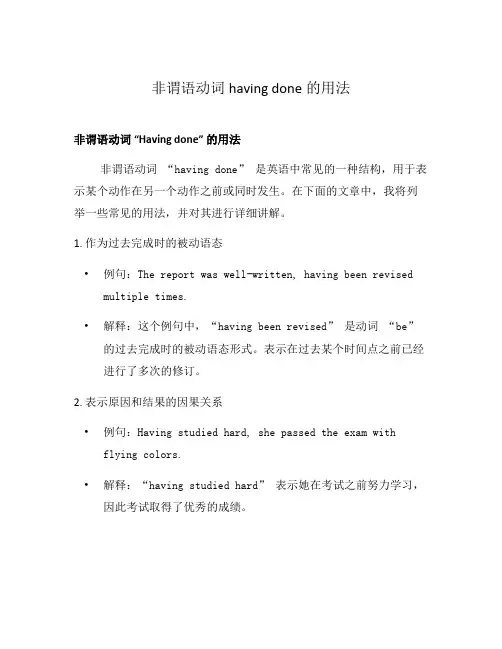
非谓语动词having done的用法非谓语动词“Having done” 的用法非谓语动词“having done” 是英语中常见的一种结构,用于表示某个动作在另一个动作之前或同时发生。
在下面的文章中,我将列举一些常见的用法,并对其进行详细讲解。
1. 作为过去完成时的被动语态•例句:The report was well-written, having been revised multiple times.•解释:这个例句中,“having been revised” 是动词“be”的过去完成时的被动语态形式。
表示在过去某个时间点之前已经进行了多次的修订。
2. 表示原因和结果的因果关系•例句:Having studied hard, she passed the exam with flying colors.•解释:“having studied hard” 表示她在考试之前努力学习,因此考试取得了优秀的成绩。
3. 作为非限定性定语从句•例句:The professor discussed the experiment, having completed it successfully.•解释:这个例句中,“having completed it successfully”是一个非限定性定语从句,修饰前面的“experiment”。
它表示在讨论实验时,教授已经顺利完成了实验。
4. 表示时间先后关系•例句:Having finished his work, he went for a walk.•解释:“having finished his work” 表示在完成了工作之后,他开始去散步。
5. 表示对过去事件的评论或判断•例句:Having heard the news, she felt relieved.•解释:“having heard the news” 表示在听到消息之后,她感到松了一口气。

2024届高三英语高考一轮复习【语法专题】非谓语动词扩展形态知识点总结(讲义)六种扩展形态being done / to be donehaving done / having been doneto have done / to have been done这个形态描述的是一种生动形象的场景感,比如下面的句子:The silence of the library is sometimes broken by a sudden cough or the sound of pages being turned.being turned描述书页正在被翻,而书页只有正在被翻的时候才会有声音,才符合句意,整个句子描述一个图书馆的场景,不知道各位能不能体会到。
除了这个基本用法以外,being done还有可能出现在主语或宾语的位置上,这个时候它不描述“正在被”,只是单纯的doing动名词的被动形式而已。
例如:Being educated in a top-level university abroad is what many students wish for.(主语)The film star wears sunglasses. Therefore, he can go shopping without being recognized.(宾语)比较简单的一个形态,就是to do的被动形式而已。
需要特别注意的是,to be done在考试里会涉及到和to do区分的情况,比如:With some books to buy, he went into the bookstore on the way home.这里如果按照规则分析,书应该是被买,所以貌似写成with some books to be bought才合理。
类似的例子还有:With some urgent business to attend to, Mr. Smith has decided to put off his journey to Paris.紧急的事务应该是被参与,是不是应该写成with some urgent business to be attended to?答案当然是否定的。
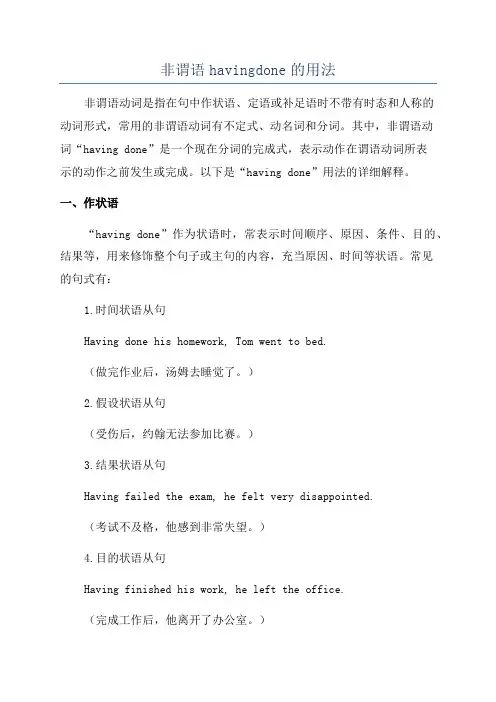
非谓语havingdone的用法非谓语动词是指在句中作状语、定语或补足语时不带有时态和人称的动词形式,常用的非谓语动词有不定式、动名词和分词。
其中,非谓语动词“having done”是一个现在分词的完成式,表示动作在谓语动词所表示的动作之前发生或完成。
以下是“having done”用法的详细解释。
一、作状语“having done”作为状语时,常表示时间顺序、原因、条件、目的、结果等,用来修饰整个句子或主句的内容,充当原因、时间等状语。
常见的句式有:1.时间状语从句Having done his homework, Tom went to bed.(做完作业后,汤姆去睡觉了。
)2.假设状语从句(受伤后,约翰无法参加比赛。
)3.结果状语从句Having failed the exam, he felt very disappointed.(考试不及格,他感到非常失望。
)4.目的状语从句Having finished his work, he left the office.(完成工作后,他离开了办公室。
)二、作定语“having done”作为定语时,常用于名词或代词之后,修饰主语,表示主语在句意中的其中一动作已经完成。
1.名词的定语The boy, having finished his homework, went out to play.(那个男孩完成了作业后,出去玩了。
)2.代词的定语She went upstairs, having found the keys.(她找到钥匙后去楼上了。
)三、作补足语“having done”作为补足语时,常跟在宾语之后,用来修饰或补充说明宾语的内容,意义上相当于一个定语从句或独立副词。
1.补充宾语内容I'm happy with my life, having achieved my goals.(实现了我的目标,我对我的生活感到满足。
)2.与宾语同时发生的动作She sat down, having put the heavy bag on the floor.(她放下沉重的包后坐下来。

非谓语动词用法总结-标准化文件发布号:(9556-EUATWK-MWUB-WUNN-INNUL-DDQTY-KII非谓语动词用法总结非谓语动词作主语一.动词不定式作主语1.不定式作主语表示具体的动作,通常指一件已知的事或目的。
不定式作主语时,谓语动词用单数。
To say is a thing,to do is another.(说是一回事,做是另外一回事。
)2. 不定式短语较长时,通常放在谓语之后,用it作形式主语。
①It is important to learn English well.(学好英语是重要的。
)②It is necessary for us to do the job well.(我们做好这项工作是必要的。
)③It is a great honor to be invited to give a speech here.(被邀请在这儿发表演讲是一个极大的荣幸。
)二.动词ing不定式作主语1.动名词做主语往往表示经常性、习惯性的动作或状态。
Watching news on TV has become a routine for me.(经常性、习惯性的动作)Talking is easier than doing.(状态)(1)动名词直接置于句首。
Talking is easier than doing.(2).Ving 形式作主语时常后置,用it作形式主语Playing video games is a waste of timeIt is a waste of time playing video games常见句式:It is no good/no use/ useless doing sth 做...没有用的It is a waste of time doing sth做...是浪费时间的(3).There be 结构中作主语:A. There is no+doing 表示不可能做某事There is no knowing the future ==we can’t know the future. 我们不可能知道未来发生什么B.There is no point doing 做某事没有意义There’s no point having wishes if you don’t at least try to do them.拓展:动名词作主语时,单个V-ing 做主语,谓语动词用单数。
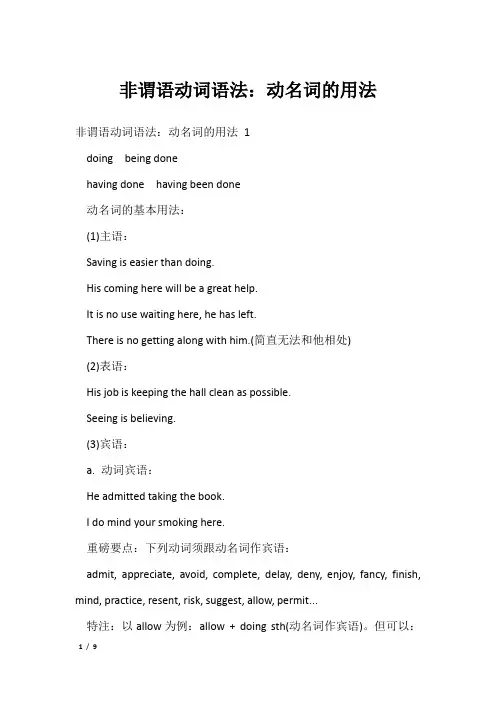
非谓语动词语法:动名词的用法非谓语动词语法:动名词的用法1doing being donehaving done having been done动名词的基本用法:(1)主语:Saving is easier than doing.His coming here will be a great help.It is no use waiting here, he has left.There is no getting along with him.(简直无法和他相处)(2)表语:His job is keeping the hall clean as possible.Seeing is believing.(3)宾语:a. 动词宾语:He admitted taking the book.I do mind your smoking here.重磅要点:下列动词须跟动名词作宾语:admit, appreciate, avoid, complete, delay, deny, enjoy, fancy, finish, mind, practice, resent, risk, suggest, allow, permit...特注:以allow为例:allow + doing sth(动名词作宾语)。
但可以:Allow sb to do sth(不定式作宾补)。
这类动词常见如advise, allow, permit, recommend, etc.b. 作介词宾语:He left without saying goodbye to us.Im looking forward to meeting you.(to 在这里是介词)(4)定语:reading room swimming pool walking stick动名词时态:I am thinking of setting a new dictionary.(以后)He never talked to me about his having been in Paris.(以前)动名词语态:He doesnt like being flattered.I heard of his having been chosen to be the coach of the team.动名词复合结构:由名词全部格或物主代词与动名词构成。

非谓语的9种时态表格非谓语形式一般式进行式完成式完成进行式不定式to doto be doingto have doneto have been doing- 一般式表示与谓语动作同时或之后发生。
例如:I want to go home.(同时或之后)<br> - 进行式表示与谓语动作同时进行。
例如:He seems to be reading a book. <br> - 完成式表示在谓语动作之前发生。
例如:I'm sorry to have kept you waiting. <br> - 完成进行式强调动作在谓语动作之前开始,一直持续到某个时间点且可能继续下去,较少用。
动名词doing无(本身表示动作进行)having done无- 一般式表示泛指的动作或者与谓语动作同时发生。
例如:Swimming is my favorite sport.(泛指);I enjoy reading books while having lunch.(同时)<br> - 完成式表示在谓语动作之前发生的动作。
例如:He was praised for having made great progress.现在分词doingbeing donehaving donehaving been doing- 一般式(主动)表示与谓语动作同时进行或存在的主动动作。
例如:The girl standing there is my sister.(同时进行)<br> - 一般式(被动)being done表示正在被进行的动作。
例如:The house being built is for the old. <br> - 完成式(主动)having done表示在谓语动作之前发生的主动动作。
例如:Having finished his homework, he went out to play. <br> - 完成式(被动)havingbeen done表示在谓语动作之前发生且被完成的动作。
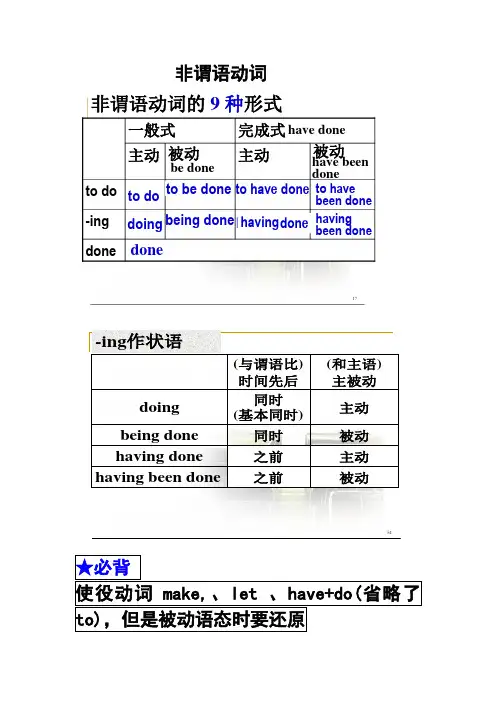
非谓语动词 17done -ing to do 被动主动被动主动完成式一般式to do doing doneto be done being done to have done have done to have been donehaving been done having be done have done have been done51被动之前having been done主动之前having done 被动同时being done 主动同时(基本同时)doing (和主语)主被动(与谓语比)时间先后-ing 作状语★必背使役动词make,、let 、have+do(省略了感官动词see/ watch/hear/feel1: +do(一般现在和一般过去,不强调正在进行都可用)I saw the boys fight with each other yesterday.PS: 被动态时需要还原“to ”The boys were seen to fight with each other yesterday.2: +doing (强调正在进行)The girl reported seeing a beautiful bird flying toward the window. 14非谓语动词题目三步走:⏹是否已存在另一个动作(不管前面还是后面)⏹主被动关系⏹时间先后顺序◆习题 ◆⏹S he reached the top of the hill andstopped on a big rock to see the rising sun.A. to have restedB. restingC. to restD. rest⏹Y ou were brave enough to raiseobjections at the meeting.Well, now I regret _ that.A. to doB. to be doingC. to have doneD. having done⏹T hey knew her very well. They hadseen her _ up from childhood.A. growB. grewC. was growingD. to grow⏹I’ve heard him _ about you often.A. talkedB. talksC. talkD. to talk⏹I f you think that treating a womanwell means always _ her permission for things,think again. (06湖南) A. gets B. got C. to get D. getting⏹H e walked down the hills, _ softly tohimself。
精心整理非谓语动词用法归纳/Youshouldtrytoavoidmakingmistakes. Thebookisworthreading.Thebookdeservesreading.(2)表进行Walkingonthegrassland,Isawasnake.=WhenIwaswalkingonthegr assland,Isawasnake.ThemanspeakingEnglishisTom.=ThemanwhoisspeakingEnglishis Tom.(3)表主动ThemanspeakingEnglishisTom=ThemanwhospeaksEnglishisTom.=ThemanwhospokeEnglishisTo m.Nobodydinksboilingwaterbutboiledwater.=Nobodydinkswatert hatisboilingbutthewaterthathasboiled.(4)表伴随IstandoutsidewaitingforMr.Chen. Ilieinbedreadinganovel.(5)表性质;特点((词Havingdonethework,Ihadashortrest.=AfterIhaddonethework,I hadashortrest.Havingdonethework,Iwentbackhome.Havingbeendone,theworkwascheckedbytheleaders.4.havingbeendone用于句首;有先后动作表完成有先后动作表完成,(有过去时间或过去动作)Iappreciatehavingbeengiventheopportunitytostudyabroad twoyearsago.(要求动词后)=IappreciatethatIwasgiventheopportunitytostudyabroadt woyearsago.Havingbeengiventheopportunitytostudyabroadtwoyearsago ,Istillappreciateyourhelpthen.=BecauseIwasgiventheopportunitytostudyabroadtwoyearsa go,IstillappreciateyourhelpthenIappreciatehavingbeengiventheopportunitytostudyabroad twoyearsago.IenjoygivingtheopportunitytostudyabroadtoMr.Wang.Iappreciatebeinggiventheopportunitytostudyabroadnow.得请求注定能够碰巧long忽视计划/允许try想要始干。
非谓语动词在句子中充当除谓语以外的句子成分的动词形式叫做非谓语动词。
非谓语动词分为三种形式:不定式,动名词,和分词(分词包括现在分词和过去分词)。
1)不定式时态\语态主动被动一般式to do to be done完成式to have done to have been done2)动名词时态\语态主动被动一般式doing being done完成式having done having been done3)分词时态\语态主动被动一般式doing being done完成式having done having been done否定形式:not +不定式,not + 动名词,not + 现在分词动名词1 动名词作主语、宾语和表语1)作主语Fighting broke out between the South and the North.南方与北方开战了。
2)作宾语a. 动词后加动名词doing作宾语V. + doing sthadmit 承认appreciate 感激,赞赏avoid 避免complete 完成consider 认为delay 耽误deny 否认detest 讨厌endure 忍受enjoy 喜欢escape 逃脱prevent阻止fancy 想象finish 完成imagine 想象mind 介意miss 想念postpone 推迟practise 训练recall 回忆resent 讨厌resist 抵抗resume 继续risk 冒险suggest 建议face 面对include 包括stand 忍受understand 理解forgive 宽恕keep 继续举例:(1)Would you mind turning down your radio a little, please?(2)The squirrel was lucky that it just missed being caught.b. 词组后接doingadmit to prefer…to be used to lead to devote oneself to object to stick to busy look forward to(to为介词)no good,no use,It's worth…,as well as,can't help,It's no use /good be tired ofbe fond of be capable of be afraid ofbe proud of think of / about hold offput off keep on insist on count on / uponset about be successful in good at take upgive up burst out pre vent … from…3)作表语Her job is washing,cleaning and taking care of the children.动词不定式1 不定式作宾语1) 动词+ 不定式afford aim appear agree arrange ask be decide bother care choose come dare demand desire determine expect elect endeavor hope fail happen help hesitate learn long mean manage offer ought plan prepare pretend promise refuse seem tend wait wish undertake举例:The driver failed to see the other car in time.司机没能及时看见另一辆车。
探究非谓语动词 having done 和 having been done 的应用在英语语法中,非谓语动词做伴随状语的情况比较常见,其中 having done 和 having been done 是两个常用的形式。
本文将介绍它们的含义、用法和区别。
下面是本店铺为大家精心编写的5篇《探究非谓语动词 having done 和 having been done 的应用》,供大家借鉴与参考,希望对大家有所帮助。
《探究非谓语动词 having done 和 having been done 的应用》篇1一、having done 的用法having done 是现在分词的完成式,表示动作在谓语动词之前发生,并且对谓语动词有伴随作用。
having done 通常用于以下几种情况:1. 完成式的伴随状语having done 可以用于完成式的伴随状语,表示在谓语动词之前完成的动作。
例如:- Having finished my homework, I went to bed.(完成作业后,我去睡觉了。
)2. 结果状的伴随状语having done 还可以用于结果状的伴随状语,表示动作完成的结果。
例如:- Having broken his arm, he had to go to the hospital.(摔断手臂后,他不得不去医院。
)二、having been done 的用法having been done 是现在分词的完成被动式,表示被动动作在谓语动词之前发生,并且对谓语动词有伴随作用。
having been done 通常用于以下几种情况:1. 被动式的伴随状语having been done 可以用于被动式的伴随状语,表示在谓语动词之前发生的被动动作。
例如:- Having been invited to the party, she was excited to attend.(被邀请参加聚会后,她很兴奋地去了。
2-3非谓语:现在分词主动被动现在分词的一般式现在分词的完成式现在分词的否定式The question being discussed is important.Being a student, he was interested in books.Having studied in university for 3 years, he knows the way very well.Having been criticized by the teacher, Li Ming gave up smoking.现在分词及其短语的句法功能:1. 作定语可以改成相应的定语从句eg. a running boy =a boy who is runningthe girl standing there = a girl who is standing thereThe working people are the wisest.The farmers working here are very busy.Those sitting in the front were all our foreign guests. .2. 作表语The story he told to us was very interesting.I am interested in the story he told me.3. 作补语1)现在分词可用作补语(主补、宾补),强调动作的进行或状态;过去分词则表示完成或被动。
Soon steam can be seen coming out of the liquid.不久,就能看到气体从液体中逸出。
★see, watch, catch, hear, feel, find, get, keep, notice, have+ sb/sth+ doingHe kept us waiting for a whole hour.他让我们等了整整一小时。
having done 做主语
“Having done”是一个完成时态的动词短语,通常用作句子的主语、主语补语或状语。
它的意思是“已经完成了某件事情”。
举个例子,假设我们有这样一句话,"Having done all my homework, I went to bed early.",它的意思是“我已经完成了所有的家庭作业,然后早早就上床睡觉了”。
在这个句子中,“having done”是主语补语。
它说明了主语“我”完成了所有的家庭作业,然后才去睡觉。
另外,这个短语也可以作为一个状语,如“Having done my workout, I took a shower.”,意思是“我做完了锻炼,然后洗了个澡”。
总之,“having done”是一个形式上比较复杂但用途广泛的动词短语,它可以在句子中发挥多种不同的语法作用。
非谓语having done的用法
非谓语中的having done是现在分词的完成式,它表示主动的动作,并且动作发生在谓语动词之前,常常作状语来修饰动词。
done过去分词无论作状语或作定语,都表示被动的动作,也可以表示已经完成的动作。
having done例句
Having done these things, he went on again.
做完这些事,他又继续往前走。
Having done quite well in the important exam, he came back home, relaxed and smiling.
他在这场重要的考试中做得很好,他放松地回到家,面带微笑。
It would be rash to try an exam like BEC Higher without having done any preparation at all, even if your English is very good.
即使你的英语很好,如果你没有做任何准备就参加BEC 高级考试,那也太草率了。
You can congratulate yourself on having done an excellent job.
你应该为你出色的工作感到自豪。
Having done that,she now could rest.
做完了这些事,现在她可以安息了。
He felt ashamed of having done so little.
他为自己干得太少而感到羞愧。